Papers by Catherine Guynet
Ecosal plus, May 9, 2023
DNA segregation ensures that cell offspring receive at least one copy of each DNA molecule, or re... more DNA segregation ensures that cell offspring receive at least one copy of each DNA molecule, or replicon, after their replication. This important cellular process includes different phases leading to the physical separation of the replicons and their movement toward the future daughter cells. Here, we review these phases and processes in enterobacteria with emphasis on the molecular mechanisms at play and their controls.
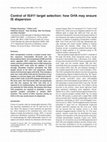
Molecular Microbiology, Jan 22, 2007
IS911 transposition involves a closed circular insertion sequence intermediate (IS-circle) and tw... more IS911 transposition involves a closed circular insertion sequence intermediate (IS-circle) and two IS-encoded proteins: the transposase OrfAB and OrfA which regulates IS911 insertion. OrfAB alone promotes insertion preferentially next to DNA sequences resembling IS911 ends while the addition of OrfA strongly stimulates insertion principally into DNA targets devoid of the IS911 end sequences. OrfAB shares its N-terminal region with OrfA. This includes a helix-turn-helix (HTH) motif and the first three of four heptads of a leucine zipper (LZ). OrfAB binds specifically to IS911 ends via its HTH whereas OrfA does not. We show here: that OrfA binds DNA non-specifically and that this requires the HTH; that OrfA LZ is required for its multimerization; and that both motifs are essential for OrfA activity. We propose that these OrfA properties are required to assemble a nucleoprotein complex committed to random IS911 insertion. This control of IS911 insertion activity by OrfA in this way would assure its dispersion.
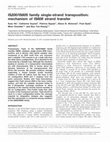
Nucleic Acids Research, Jan 23, 2013
Transposase, TnpA, of the IS200/IS605 family member IS608, catalyses single-strand DNA transposit... more Transposase, TnpA, of the IS200/IS605 family member IS608, catalyses single-strand DNA transposition and is dimeric with hybrid catalytic sites composed of an HUH motif from one monomer and a catalytic Y127 present in an a-helix (aD) from the other (trans configuration). aD is attached to the main body by a flexible loop. Although the reactions leading to excision of a transposition intermediate are well characterized, little is known about the dynamic behaviour of the transpososome that drives this process. We provide evidence strongly supporting a strand transfer model involving rotation of both aD helices from the trans to the cis configuration (HUH and Y residues from the same monomer). Studies with TnpA heterodimers suggest that TnpA cleaves DNA in the trans configuration, and that the catalytic tyrosines linked to the 5 0-phosphates exchange positions to allow rejoining of the cleaved strands (strand transfer) in the cis configuration. They further imply that, after excision of the transposon junction, TnpA should be reset to a trans configuration before the cleavage required for integration. Analysis also suggests that this mechanism is conserved among members of the IS200/IS605 family.
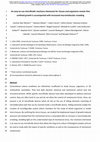
bioRxiv (Cold Spring Harbor Laboratory), Mar 30, 2023
Conventional culture conditions are oftentimes insufficient to study tissues, organisms, or 3D mu... more Conventional culture conditions are oftentimes insufficient to study tissues, organisms, or 3D multicellular assemblies. They lack both dynamic chemical and mechanical control over the microenvironment. While specific microfluidic devices have been developed to address chemical control, they are often hard to use and do not allow the control of compressive forces. Here, we present a set of microfluidic devices which all rely on the use of sliding elements consisting of microfabricated rods that can be inserted inside a microfluidic device. Sliding elements enable the creation of reconfigurable sealed culture chambers for the study of whole organisms or model micro-tissues. By confining the micro-tissues, we studied the biophysical impact of growth-induced pressure and showed that this mechanical stress is associated with an increase in macromolecular crowding, shedding light on this understudied type of mechanical stress. Our mechano-chemostat is an easy-to-use microfluidic device that allows the long-term culture of biological samples and can be used to study both the impact of specific conditions as well as the consequences of mechanical compression. .
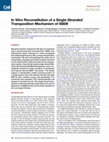
Molecular Cell, Feb 1, 2008
Bacterial insertion sequences (IS) play an important role in restructuring their host genomes. IS... more Bacterial insertion sequences (IS) play an important role in restructuring their host genomes. IS608, from Helicobacter pylori, belongs to a newly recognized and widespread IS group with a unique transposition mechanism. We have reconstituted the entire set of transposition cleavage and strand transfer reactions in vitro and find that, unlike any other known transposition system, they strictly require single-strand DNA. TnpA, the shortest identified transposase, uses a nucleophilic tyrosine for these reactions. It recognizes and cleaves only the IS608 ''top strand.'' The results support a transposition model involving excision of a single-strand circle with abutted left (LE) and right (RE) IS ends. Insertion occurs site specifically 3 0 to conserved and essential TTAC tetranucleotide and appears to be driven by LE. This single-strand transposition mode has important implications not only for dispersion of IS608 but also for the other members of this very large IS family.
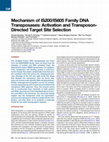
Cell, 2008
The smallest known DNA transposases are those from the IS200/IS605 family. Here we show how the i... more The smallest known DNA transposases are those from the IS200/IS605 family. Here we show how the interplay of protein and DNA activates TnpA, the Helicobacter pylori IS608 transposase, for catalysis. First, transposon end binding causes a conformational change that aligns catalytically important protein residues within the active site. Subsequent precise cleavage at the left and right ends, the steps that liberate the transposon from its donor site, does not involve a site-specific DNA-binding domain. Rather, cleavage site recognition occurs by complementary base pairing with a TnpA-bound subterminal transposon DNA segment. Thus, the enzyme active site is constructed from elements of both protein and DNA, reminiscent of the interdependence of protein and RNA in the ribosome. Our structural results explain why the transposon ends are asymmetric and how the transposon selects a target site for integration, and they allow us to propose a molecular model for the entire transposition reaction.
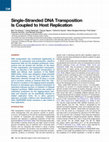
Cell, Aug 1, 2010
DNA transposition has contributed significantly to evolution of eukaryotes and prokaryotes. Inser... more DNA transposition has contributed significantly to evolution of eukaryotes and prokaryotes. Insertion sequences (ISs) are the simplest prokaryotic transposons and are divided into families on the basis of their organization and transposition mechanism. Here, we describe a link between transposition of IS608 and ISDra2, both members of the IS200/ IS605 family, which uses obligatory single-stranded DNA intermediates, and the host replication fork. Replication direction through the IS plays a crucial role in excision: activity is maximal when the ''top'' IS strand is located on the lagging-strand template. Excision is stimulated upon transient inactivation of replicative helicase function or inhibition of Okazaki fragment synthesis. IS608 insertions also exhibit an orientation preference for the lagging-strand template and insertion can be specifically directed to stalled replication forks. An in silico genomic approach provides evidence that dissemination of other IS200/IS605 family members is also linked to host replication.
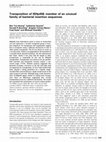
The EMBO Journal, Sep 15, 2005
ISHp608 from Helicobacter pylori is active in Escherichia coli and represents a recently recognis... more ISHp608 from Helicobacter pylori is active in Escherichia coli and represents a recently recognised group of insertion sequences. Its transposase and organisation suggest that it transposes using a different mechanism to that of other known transposons. The IS was shown to excise as a circular form, which is accompanied by the formation of a resealed donor plasmid backbone. We also demonstrate that TnpA, which is less than half the length of other transposases, is responsible for this and for ISHp608 transposition. Transposition was shown to be site specific: both insertion and transposon excision require a conserved target, 5 0 TTAC. Deletion analysis suggested that potential secondary structures at the left and right ends are important for transposition. In vitro TnpA bound both ends, showed a strong preference for a specific singlestranded DNA and introduced a single-strand break on the same strand at each end. Although many of the characteristics of ISHp608 appear similar to rolling-circle transposons, there are differences suggesting that, overall, transposition occurs by a different mechanism. The results have permitted the formulation of several related models.
Methods in molecular biology, Oct 5, 2019
Bacterial transposons, through their ability to transfer DNA sequences from one position in the g... more Bacterial transposons, through their ability to transfer DNA sequences from one position in the genome to another, play a central role in the shape and the evolution of genomes. Extensive studies have been performed during the last five decades to understand the molecular mechanisms involved in the transposition of a variety of elements. Among the methods used, the papillation and the mating out coupled to arbitrary primed PCR assays described in this chapter are widely used as very powerful approaches to detect and characterize transposition events in vivo.
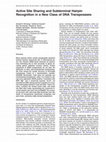
Molecular Cell, Oct 1, 2005
Many bacteria harbor simple transposable elements termed insertion sequences (IS). In Helicobacte... more Many bacteria harbor simple transposable elements termed insertion sequences (IS). In Helicobacter pylori, the chimeric IS605 family elements are particularly interesting due to their proximity to genes encoding gastric epithelial invasion factors. Protein sequences of IS605 transposases do not bear the hallmarks of other well-characterized transposases. We have solved the crystal structure of full-length transposase (TnpA) of a representative member, ISHp608. Structurally, TnpA does not resemble any characterized transposase; rather, it is related to rolling circle replication (RCR) proteins. Consistent with RCR, Mg 2+ and a conserved tyrosine, Tyr127, are essential for DNA nicking and the formation of a covalent intermediate between TnpA and DNA. TnpA is dimeric, contains two shared active sites, and binds two DNA stem loops representing the conserved inverted repeats near each end of ISHp608. The cocrystal structure with stem-loop DNA illustrates how this family of transposases specifically recognizes and pairs ends, necessary steps during transposition.
Lab on a Chip
Structure sliding-elements allow for 3D culture of tissues, organisms or 3D multicellular organis... more Structure sliding-elements allow for 3D culture of tissues, organisms or 3D multicellular organisms in microfluidic systems.











Uploads
Papers by Catherine Guynet